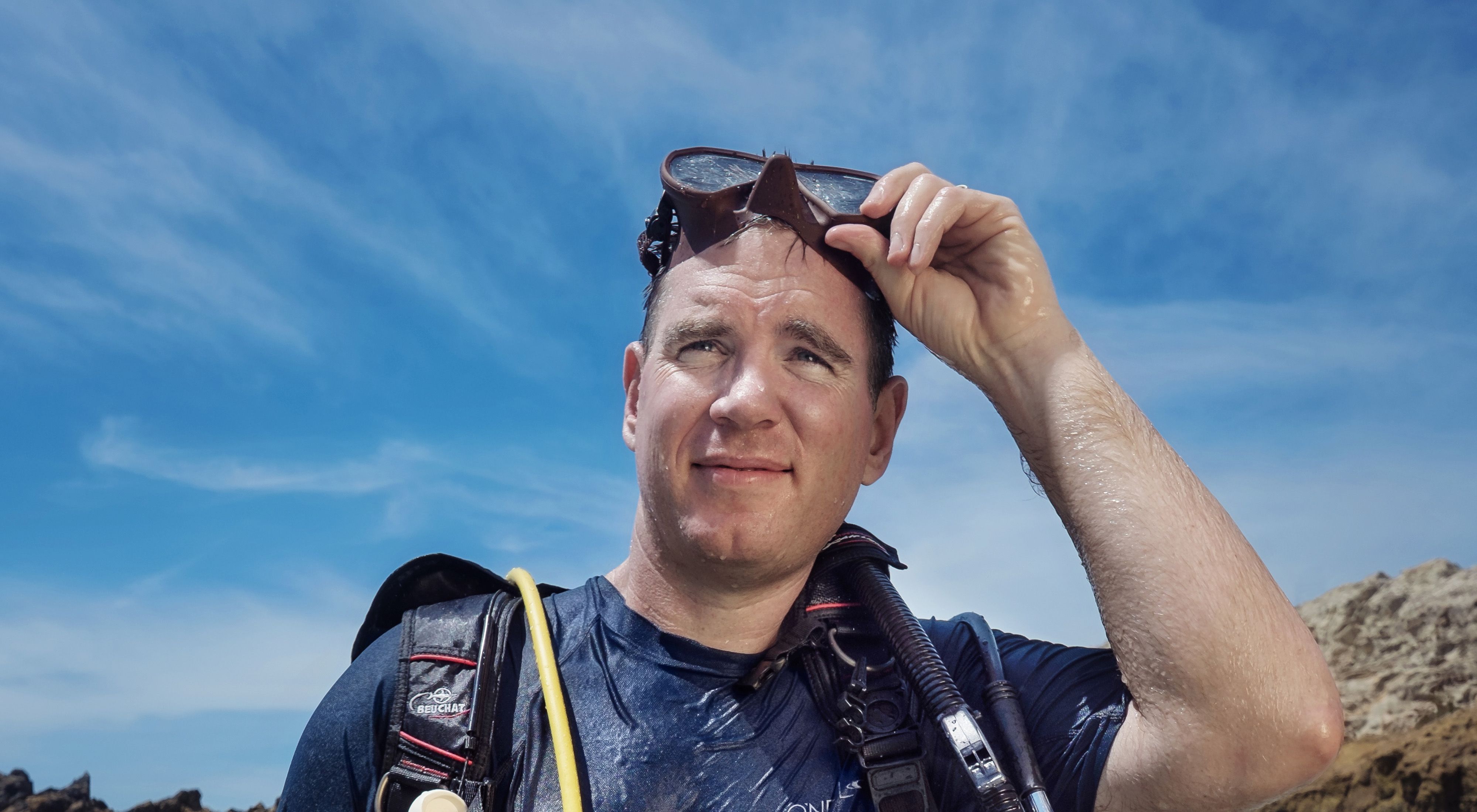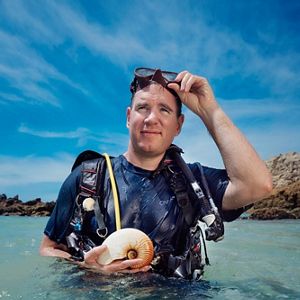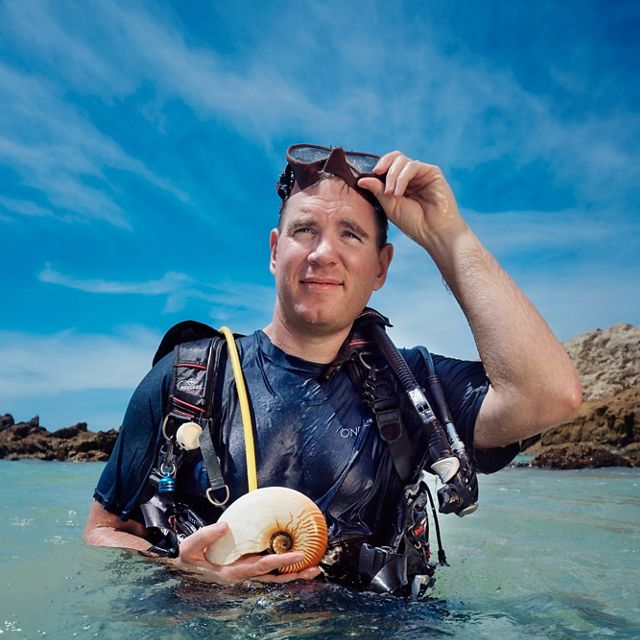Nautical Quest
Marine scientist Rick Hamilton embarks on a search for a deepwater nautilus not seen in decades.
June/July 2016
The empty shells of the crusty nautilus wash ashore in Papua New Guinea from time to time, but no one has seen the animals alive since the 1980s. Formally named Allonautilus scrobiculatus, the deep-water creature gets its name because of a slimy layer—a crust—of protein on its shell. As a marine biologist working in the Pacific for the Conservancy, I have wondered for years if this species is even still living here?
Early one morning in July 2015, I set out to find the answer, embarking on a journey to the waters of Papua New Guinea in search of this rare species. My partners on this scientific expedition—Peter Ward, one of the scientists who last found a live specimen more than 30 years ago, and nautilus biologist Gregory Barord—hope that we will be the first to get video footage of the species.
Our journey has taken on a sense of urgency because Papua New Guinea has moved rapidly in recent years into an unprecedented age of deep-sea mining. Documenting what exists in some of these deep-water ecosystems before they are altered by industry may be the key to their protection.
From Brisbane, we fly to Port Moresby, the capital of Papua New Guinea, then on to Kavieng, New Ireland Province. There, local fishermen from the nearby Tigak Islands tell us that shells of the crusty nautilus and the more common pearly nautilus, Nautilus pompilius, have recently washed ashore. With this clue, we feel certain that we will find a live crusty nautilus in the waters nearby.
Steering a boat into the deep water off New Ireland, we begin lowering rectangular metal traps to the ocean floor, 1,000 feet below the surface. We also set up video cameras to record information on the species there.
But after a week of trapping and filming, we find no sign of the crusty nautilus. We concede that either our assumptions about the animal are wrong, or we simply set our traps in the wrong locations.
Undeterred, we fly on to Papua New Guinea’s Manus Province. Here we meet Conservancy staff member and canoe builder Manuai Matawai. We load our gear into his voyaging canoe, the Climate Challenger, and sail several hours south to Ndrova Island, where Peter Ward last saw a live crusty nautilus in 1984. As we arrive on the beach, we are greeted by Peter Kanawi, the island’s chief, and Pongie Kichawen, the director of a network of tribal communities that has recently designated their seascape as a protected area. They introduce us to 18 members of the nearby Mbunai community who will be assisting us in the search.
Eager to get started that night, we climb onto an outboard engine-powered banana boat, steer out to deep water and lower two traps. Buoys mark the traps’ locations at the water’s surface.
The next morning we head back to sea. Ward is unusually quiet and visibly anxious, and the excitement among our group of voyagers is palpable. We had dropped a tiny box to the bottom of the ocean, and we were about to find out what treasures might be inside. But as our boat pulls up to where we’d left the first trap the night before, the buoy is nowhere to be seen. After searching for some time, we spot it several miles away. The trap had drifted in strong currents during the night, and is now in water well over 1,000 feet deep. Members of our team pull it up—hand over hand like a game of tug-of-war. But the cage is empty. We move quickly to the second trap, which has also moved with the night’s currents. It too is empty. Our entire team visibly deflates. Perhaps the crusty nautilus is no longer here. Perhaps the clues aren’t as strong as we had thought.ocean, and we were about to find out what treasures might be inside.
But as our boat pulls up to where we’d left the first trap the night before, the buoy is nowhere to be seen. After searching for some time, we spot it several miles away. The trap had drifted in strong currents during the night, and is now in water well over 1,000 feet deep.
Members of our team pull it up—hand over hand like a game of tug-of-war. But the cage is empty. We move quickly to the second trap, which has also moved with the night’s currents. It too is empty.
Our entire team visibly deflates. Perhaps the crusty nautilus is no longer here. Perhaps the clues aren’t as strong as we had thought.
We regroup after lunch and plan a new approach: A few elder Mbunai fishermen who remember Ward’s 1984 expedition recall that his team found specimens in slightly shallower waters. We decide to heed their advice.
We head out once again, lower the traps in shallower waters and wait out the night back at Ndrova Island.
The following morning, the team slowly raises the first trap. When the cage comes into view, I am unable to wait any longer and free-dive down to inspect it. I can hardly contain my excitement when I count three pearly and three crusty nautiluses inside.
I surface as fast as I can and shout the news to everyone waiting on the boat. We all go wild, whooping and clapping one another’s backs. Ward, Barord, Matawai and I pull on our scuba gear, I grab my GoPro camera, and soon we are filming crusty nautiluses underwater around a coral reef. Later that day we attach tiny acoustic tags to the shells of both nautilus species so that we can track their movements and learn more about the depth and temperature ranges that they venture into.
We had done it. Our team of scientists, conservationists, provincial fisheries staff and community members had found and filmed a crusty nautilus for the first time, and we were now learning previously unknown information about this elusive marine species.
Rick Hamilton, a marine scientist in Australia, directs The Nature Conservancy’s Melanesia Program.


